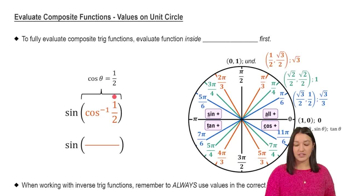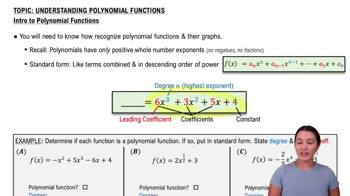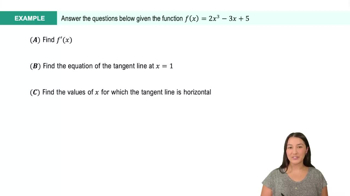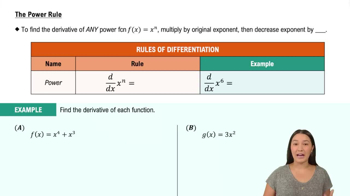Table of contents
- 0. Functions7h 52m
- Introduction to Functions16m
- Piecewise Functions10m
- Properties of Functions9m
- Common Functions1h 8m
- Transformations5m
- Combining Functions27m
- Exponent rules32m
- Exponential Functions28m
- Logarithmic Functions24m
- Properties of Logarithms34m
- Exponential & Logarithmic Equations35m
- Introduction to Trigonometric Functions38m
- Graphs of Trigonometric Functions44m
- Trigonometric Identities47m
- Inverse Trigonometric Functions48m
- 1. Limits and Continuity2h 2m
- 2. Intro to Derivatives1h 33m
- 3. Techniques of Differentiation3h 18m
- 4. Applications of Derivatives2h 38m
- 5. Graphical Applications of Derivatives6h 2m
- 6. Derivatives of Inverse, Exponential, & Logarithmic Functions2h 37m
- 7. Antiderivatives & Indefinite Integrals1h 26m
- 8. Definite Integrals4h 44m
- 9. Graphical Applications of Integrals2h 27m
- 10. Physics Applications of Integrals 2h 22m
3. Techniques of Differentiation
Basic Rules of Differentiation
Problem 3.43a
Textbook Question
City urbanization City planners model the size of their city using the function A(t) = - 1/50t² + 2t +20, for 0 ≤ t ≤ 50, where A is measured in square miles and t is the number of years after 2010.
a. Compute A'(t). What units are associated with this derivative and what does the derivative measure?
 Verified step by step guidance
Verified step by step guidance1
Step 1: Identify the function A(t) = -\frac{1}{50}t^2 + 2t + 20. This is a quadratic function representing the size of the city in square miles as a function of time t, where t is the number of years after 2010.
Step 2: To find the derivative A'(t), apply the power rule of differentiation. The power rule states that if f(t) = at^n, then f'(t) = nat^{n-1}.
Step 3: Differentiate each term of A(t) separately. For the first term, -\frac{1}{50}t^2, apply the power rule to get -\frac{2}{50}t. For the second term, 2t, the derivative is 2, and for the constant term 20, the derivative is 0.
Step 4: Combine the derivatives of each term to find A'(t). This results in A'(t) = -\frac{2}{50}t + 2.
Step 5: Interpret the derivative A'(t). The units of A'(t) are square miles per year, as it represents the rate of change of the city's size with respect to time. It measures how quickly the area of the city is changing each year.
 Verified video answer for a similar problem:
Verified video answer for a similar problem:This video solution was recommended by our tutors as helpful for the problem above
Video duration:
5mPlay a video:
Was this helpful?
Key Concepts
Here are the essential concepts you must grasp in order to answer the question correctly.
Derivative
The derivative of a function measures the rate at which the function's value changes with respect to changes in its input. In this context, A'(t) represents the instantaneous rate of change of the area A with respect to time t. It provides insight into how quickly the size of the city is growing or shrinking at any given year after 2010.
Recommended video:

Derivatives
Units of Measurement
In this problem, the function A(t) is measured in square miles, and t is measured in years. Therefore, the derivative A'(t) will have units of square miles per year, indicating how many square miles the area of the city increases or decreases each year. Understanding the units is crucial for interpreting the derivative's meaning in a real-world context.
Recommended video:

Evaluate Composite Functions - Values on Unit Circle
Quadratic Functions
The function A(t) = -1/50t² + 2t + 20 is a quadratic function, characterized by its parabolic shape. Quadratic functions can model various real-world phenomena, including growth and decay. In this case, the negative coefficient of the t² term suggests that the area may eventually decrease after reaching a maximum, which is important for city planners to consider in urbanization strategies.
Recommended video:

Introduction to Polynomial Functions

 3:59m
3:59mWatch next
Master Derivatives of Linear Functions with a bite sized video explanation from Callie
Start learningRelated Videos
Related Practice







